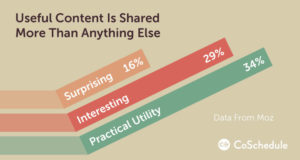 If you publish content that your customers don’t want, what good does that do anyone?
If you publish content that your customers don’t want, what good does that do anyone?
It’s tough breaking through a lot of content noise, and you’re never going to get 100% buy-in from everyone who gives you a view. But if you’re consistently writing marketing content that your customers don’t care about, you’re not going to get very far.
1. Know your audience. I know, everyone talks about the importance of this and they’re right. But even though you know your audience backwards and forwards, does your marketing writer? Do a creative brief with your employee or contractor and make sure they know who they’re writing to, and what the pain points are.
2. Match content to sales stages. Writing light technology to a technical audience at the purchase stage isn’t going to convince them to make the jump. Either is writing heavy technology to business executives at the interest stage. The former problem occurs with marketing writers that don’t have technology chops; the latter with engineers tasked with writing early stage content. Match tone and content to the audience and to their stage.
3. Use a voice that the customer wants to hear. Believe me, I can be an offender – my favorite thing to read has a lot of practical information delivered in a breezy voice with some humor. When I’m writing for my clients, they rarely want that because their customers don’t. Not their problem, mine; so I adapted to writing in various voices.
4. Let’s get real: you’re trying to sell something here. Ultimately content is about sales, and you need promotional content at the purchase and serious interest stages. Selling without being promotional is trickier at the awareness and early interest stages. These stages need content that clearly defines their pain points, and the solutions they should be looking for. If you’re good and they’re ready, they’ll sign on to your mailing list… and eventually, you will share with them that, miraculously enough, your solution clearly meets the customer’s pain points.
5. Appropriate catchy headlines. Yes, they’re important; headlines are the hook that draws readers in. A lot of the online advice out there is for very marketing-intensive emails, not technology B2B. For example, “9 Simple Ways You Can Absolutely Own Your Backup Appliance” seriously isn’t going to fly. But “Simple Tweaks Increase Backup Appliance Performance 10X” will.
6. Provide transcripts with your word-heavy videos and podcasts. Not exactly a critical tip, more a preference that might impact your response rate. Some audiophiles are great with video/audio only and no text, but visual learners like me (and there are a lot of us) don’t want to listen past a minute or less. We want to read. It’s not a big extra step to transcribe, and adds so much to your longer videos and podcasts.
Want more practical advice on creating content that sells? My pleasure.
 is also the matter of sharing: interesting, practical content — like white papers — get shared.
is also the matter of sharing: interesting, practical content — like white papers — get shared.



